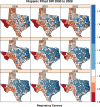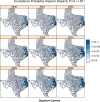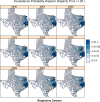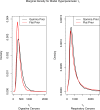An examination of disparities in cancer incidence in Texas using Bayesian random coefficient models
- PMID: 26421245
- PMCID: PMC4586809
- DOI: 10.7717/peerj.1283
An examination of disparities in cancer incidence in Texas using Bayesian random coefficient models
Abstract
Disparities in cancer risk exist between ethnic groups in the United States. These disparities often result from differential access to healthcare, differences in socioeconomic status and differential exposure to carcinogens. This study uses cancer incidence data from the population based Texas Cancer Registry to investigate the disparities in digestive and respiratory cancers from 2000 to 2008. A Bayesian hierarchical regression approach is used. All models are fit using the INLA method of Bayesian model estimation. Specifically, a spatially varying coefficient model of the disparity between Hispanic and Non-Hispanic incidence is used. Results suggest that a spatio-temporal heterogeneity model best accounts for the observed Hispanic disparity in cancer risk. Overall, there is a significant disadvantage for the Hispanic population of Texas with respect to both of these cancers, and this disparity varies significantly over space. The greatest disparities between Hispanics and Non-Hispanics in digestive and respiratory cancers occur in eastern Texas, with patterns emerging as early as 2000 and continuing until 2008.
Keywords: Bayesian modeling; Cancer incidence; Health disparities; INLA.
Conflict of interest statement
The author declares there are no competing interests.
Figures






Similar articles
-
Ethnic and border differences on blood cancer presentation and outcomes: A Texas population-based study.Cancer. 2021 Apr 1;127(7):1068-1079. doi: 10.1002/cncr.33347. Epub 2020 Dec 3. Cancer. 2021. PMID: 33616915
-
Geographic Variations of Racial/Ethnic Disparities in Late-Stage Diagnosis of Childhood Cancer in Texas.South Med J. 2020 May;113(5):224-231. doi: 10.14423/SMJ.0000000000001097. South Med J. 2020. PMID: 32358617
-
Socioeconomic deprivation as a determinant of cancer mortality and the Hispanic paradox in Texas, USA.Int J Equity Health. 2013 Apr 15;12:26. doi: 10.1186/1475-9276-12-26. Int J Equity Health. 2013. PMID: 23587269 Free PMC article.
-
Impact of heat on emergency hospital admission in Texas: geographic and racial/ethnic disparities.J Expo Sci Environ Epidemiol. 2024 Nov;34(6):927-934. doi: 10.1038/s41370-023-00590-6. Epub 2023 Aug 9. J Expo Sci Environ Epidemiol. 2024. PMID: 37558698 Review.
-
Health disparities in colorectal cancer among racial and ethnic minorities in the United States.J Gastrointest Oncol. 2016 Apr;7(Suppl 1):S32-43. doi: 10.3978/j.issn.2078-6891.2015.039. J Gastrointest Oncol. 2016. PMID: 27034811 Free PMC article. Review.
Cited by
-
Spatiotemporal variation in the risk of out-of-hospital cardiac arrests in Queensland, Australia.Resusc Plus. 2021 Sep 21;8:100166. doi: 10.1016/j.resplu.2021.100166. eCollection 2021 Dec. Resusc Plus. 2021. PMID: 34604821 Free PMC article.
-
Spatiotemporal high-resolution prediction and mapping: methodology and application to dengue disease.J Geogr Syst. 2022;24(4):527-581. doi: 10.1007/s10109-021-00368-0. Epub 2022 Feb 19. J Geogr Syst. 2022. PMID: 35221792 Free PMC article.
-
A Bayesian spatio-temporal analysis on racial disparities in hypertensive disorders of pregnancy in Florida, 2005-2014.Spat Spatiotemporal Epidemiol. 2019 Jun;29:43-50. doi: 10.1016/j.sste.2019.03.002. Epub 2019 Apr 6. Spat Spatiotemporal Epidemiol. 2019. PMID: 31128630 Free PMC article.
-
Bayesian inference in racial health inequity analyses for noncommunicable diseases: a systematic review.Syst Rev. 2025 Jul 10;14(1):145. doi: 10.1186/s13643-025-02898-w. Syst Rev. 2025. PMID: 40640883 Free PMC article.
References
-
- Banerjee S, Carlin BP, Gelfand AE. Hierarchical modeling and analysis for spatial data. Boca Raton: CRC/Chapman & Hall; 2004.
-
- Besag J, York J, Mollie A. Bayesian image restoration, with two applications in spatial statistics. Annals of the Institute of Statistical Mathetmatics. 1991;43:1–59. doi: 10.1007/BF00116466. - DOI
LinkOut - more resources
Full Text Sources
Other Literature Sources

